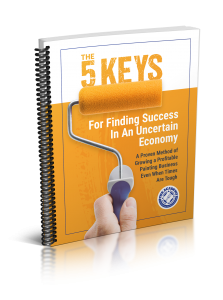3 Essential Steps to Profitably Sell Your Painting Business
One frequently asked question I get is, “Brandon, how did you sell your painting business for as much money as you did, and how did you build it up so quickly to sell it?” If you’re thinking about selling your painting business, now is the time to start working on it. The reality is that most painters can’t sell their business when they’re ready to, or, if they can, they get very little out of a company they’ve spent a lifetime growing. If selling your business is something you’re interested in, there are steps you need to take now to not only sell your business but make a lot of money doing it.
I’m going to walk you through what I think are the three essential steps for profitably selling a painting business. But first, let’s talk about reality, which is not very good. Most painting contractors cannot sell their business. When they get ready to retire, they just shut the doors. They roll their equipment out on the sidewalk, call some fellow painters over and they haggle over it. Maybe walk away with, I don’t know, 10, $15,000, and you’re done. That is a shame, to spend a lifetime working on a business, only to be able to get a couple of $10,000 out of it. Or, let’s say that you’ve been in the painting industry for five, seven, 15 years, and you’re ready to do something else. It happens. If you’re an entrepreneur, sometimes you want to move on and your options are limited. Again, you’re facing the same problem that you would face in retirement. In a way, you’ve just built up a job. You’ve built up an income, often a good income, but income, nonetheless. When I got my MBA, I had a professor, the only one that had ever owned his own business. It was the best class I had. Most of the rest of them were useless. He said, “Before you start a business, you better know how you’re going to sell it.” Most painting contractors start their business, never give a whole lot of thought to how you sell it. So, let’s walk through the three steps for profitably selling a painting business.
By the way, I built mine up to a little over a million dollars. I sold it for 440,000, and I should have gotten a lot more and I should have had a lot higher sales revenue, but I didn’t know what I know now. After working six years with 450 plus painting contractors, in six different countries, you learn as you interact with different businesses. You pick up best practices. You pick up different systems. So, I left a lot of money on the table. If you’re thinking about building your business, I imagine you don’t want to leave money on the table, and I don’t blame you. Here are the three steps. Let’s get started with them.
Step 1: Increase Your Personal Income
Step number one, is you have to increase your personal income. Now that sounds very obvious. When you sell your painting business, you’re going to sell it based upon a multiple of your annual income. How much money did you make? Okay?
That’s what people are going to be looking for because a painting business doesn’t have a whole lot of assets. Even if you own a building, even if you own fans and sprayers, anybody can buy that stuff for pennies on the dollar used. It’s really that promise of recurring and growing income. What that means is, your last three years in business, two years in business, at least your last year in business, although this is not how I’d recommend you do it, your income needs to be high. That means that you don’t need to be hiding money and that you don’t need to be finding every way to reduce your taxable income. You really want to show a strong income, and the term that is most often used is what I call the owner’s discretionary income and that’s, or direct to owner benefit statement. That’s everything that comes to you. It’s not just your salary and your net income, or however, you want to characterize that. It’s the truck you bought on the business, the cell phone you use, the insurance, the gym membership, whatever it is that you currently write off, that is frankly, more of a personal benefit to you than it is a necessity for the company. It’s one of the few advantages we get as small business owners, in the tax code, is that we are able to write those things off.
Step 2: Implementing Strong Business Systems
Step number one is you’ve got to increase your income. Okay? Now, how do you do that? Well, you do it through step number two, which is business systems, and business systems have two roles in selling your business. The first is, if you have strong business systems and you start implementing them and putting them in place, you can sell your business for a lot of money, a lot of money. Because, number one, you’re going to increase your personal income as a result of those systems. But the second thing it does, and this is something people overlook, is that it gives the potential buyer processes to follow. It gives them certainty. It gives them confidence that if they buy your business, things are going to go well. What they want to see is paperwork, folders, processes, training videos, templates, tools, sequences, so when they’re buying your business, they know that it’s not just all up in your head and they’re going to have to follow you around, and when you leave, it’s going to be a big, huge mess. Some of those key business systems are as follows. Your marketing system, in particular, as it relates to customer reactivation and retention. You’ve got this big, huge list of past customers. What process do you follow on a monthly and quarterly basis to make sure that they continue to buy from you?
That’s your biggest asset, your client list, and they continue to refer you, so there are those relationships. Your outbound communication, how you use mail, email, phone, text, et cetera, to stay in touch with your customers in customer reactivation campaigns, and retention efforts through newsletters, it gives them a basis where they know that if they just do nothing else, but talk to your client list, they’re going to be just fine. The second one would be sales. Okay? Your sales system. What are you doing to make sure that when you estimate a project that you’re able to sell it at an optimal closing rate and the maximum ethical charge rate. It’s very important. If you don’t have a sales system, that’s one of the first things they’re going to feel very uncomfortable about. It’s not only just the persuasive process, which is what we teach in the Power Paint presentation process. But it’s also how you use production rate estimating. If you don’t have production rates developed, and if you just look at things and tilt your head and grunt and come up with a number, they can’t do that. We’re going to talk about why they can’t do that in step number three. You need to also have operational systems. How are jobs started? Is there an ultimate crew leader packet? Is there an operational procedure or process? Is there a safe labor bonus program? Do you have your meetings set up in an agenda-driven fashion? Are there reports for your crew leaders? Are there reports for your estimators and your operations managers? All that stuff needs to be laid out. Now I can go through, I don’t know, probably 15 other systems. Another one I think I’d mentioned is how you manage your cashflow.
We even help people do that with a cash flow objection sheet. I would throw job costing in there on a daily basis. There’s like I said, probably about a dozen other systems. Not all of them have to be in place. The more you have in place, the more you learn and up to now, we’ve talked about two things, right? You’ve got to increase your personal income and business systems. Business systems actually help you increase your personal income and it makes your business very attractive. Now, there’s a secondary benefit to doing all this, to sell your business, and that is this. As you were getting your business ready to sell, you make more money. Kind of a good thing. You’d like to make as much money as you can, while you’re getting a business ready to sell, not have a fire sale, and give it away for pennies. Right?
Step 3: Selling Your Painting Business
Step number three. Now you’ve got to sell the thing. You got your business systems in place. You’ve increased your personal income. You’re having, for you, record years in personal income, especially in the last couple of years. Be great to have three years, but at least the last couple of years, and you can show people business systems and promise them, “Hey, if you buy my company and if you just do these things, you’re going to organically grow. Oh, by the way, here are our processes for net new marketing. Here are B2B relationships. Here’s how we break into commercial. Here’s the huge upside in buying my company.” Then, you get into actually selling it. Let me tell you who you probably won’t sell it to. You probably won’t sell it to a family member or a friend. You probably will not sell it to your operations manager. Whoever you sell your painting business will likely be the exact same type of person that would buy a painting franchise, except, in this case, they have more money. They have higher access to capital. You want to make sure that you get a lump sum payment at the beginning, when you sell your business. You want to make sure that you have a UCC agreement, so that if they declare bankruptcy, you’re in line, just like a mortgage company. Those are some of the legal issues. Those are some of the things you’re going to look at. But, the bigger issue is, how are you going to get leads for people to buy your business? In most cases you are not going to be equipped to find those leads, and those leads need to come from a local source, people that are looking to buy a franchise or buy a painting business.
What I’d recommend that you do is you look for a business broker or you look for a franchise dealer that might be also willing to take a flat fee, which is what I did when I sold my painting business, so that you can sell yours. They’re going to put together a financial statement. They’re going to put together everything that a bank might want to see for financing. Then, they’re going to put together a prospectus of why that client might consider buying your business. Often, I think these things are very stodgy and not done very well. I took care of all my financial statements. I have an MBA. I have a background in marketing. I can do simple accounting. I wrote all the prospectus documents. All I wanted personally were the leads.
Okay? If you send me people that are qualified to buy my business, I will evaluate them, screen them, and sell them on why it’s a great idea. That’s what I did. In your case, in most cases, you’re going to be dealing with a business broker and they’re going to handle all that for you. Now, they’re going to charge you a significant percentage, anywhere from five to 10% or whatever the rate is for selling your business. But I promise you, you’re likely to make more money in the end, if you employ someone who does this well. Now, if they do it well or not, that’s something you’re going to have to figure out. Number one is, you got to increase your income. Number two, you got to get your systems put in place for both your sanity and income, and whoever might buy it.
Number three, you’ve got to find a medium and a process through which to actually bring your business to market. Now, there’s a great book, I’d like to recommend it to you. It’s called Selling Your Business for Dummies. Now, you may think, “I’m not a dummy. Don’t recommend something that simplistic to me,” but the Dummies series typically goes out and they find the authority on something and they bring them in and they screen them, so not just anyone can write that book. I read three, I think, maybe four books on selling your business, and all of them were not very good, but the Dummies book was fantastic and it has lots of tools and templates that come with it. I think you’ll really enjoy that.
You Don’t Have to Do It Alone
Now, I can’t help you sell your business. I’m not in the business of doing that. But what I can help you do is get your business ready to sell, or make it remarkably lucrative by mentoring you and giving you our Done For You, proven business systems and plugging them in as you need them, so that you can retire or move on to something else. But, here’s the final thing I will tell you, and I’ve seen this happen time and time again. People come to me, to try to get their business ready to sell, and we work on it and we work on it. The next thing you know, six, seven, eight months into it, they’re making 50%, 30%, 100% more than they were previously. Then another three or four months rocks by, and guess what they decide? They decide they’re not selling it, because their income is doubled or tripled as they continue to work on business systems. The day-to-day stress goes down because systems reduce and eliminate problems in your painting business. If you’re thinking about selling your business, start working on it, and as it starts making a lot of money, you might decide the industry is not so bad after all, and that you’re going to keep doing it. At least, that’s what I hope you decide.
I’m Brandon Lewis with Painter’s Academy and Painter’s Weekly. If this has been helpful, and I know it has, if you’re looking for something like this, please subscribe to this channel. Please opt-in, get information from our organization, share it with your friends, put this information out there so that it’s helpful to you, but it takes time, energy, and effort. If I can ever help you, reach out and we can set up a consultation.
The 5 Keys for Success in ANY Economy

Discover the key to unlocking the hidden income potential in your painting business.
Hear What Other Members are Saying:

Jim and Lorraine
“Our first campaign reached $60,041.98! That's a huge percentage of our annual sales! You don't pick the peach orchard just one time. Different peaches ripen every day. Thanks for encouraging us to keep after it!”

Eric
“15 requests for quotes and closed and/or completed $23,000 of work and I still have a few more to do. Conservatively this campaign will net $25,000 in found money in the first 45 days! Thanks Brandon!”

Torlando
“This year has been the biggest year of growth for us. We're double where we were last year. I realized the real money in this business is in the marketing of the services - not the doing of the services.”
The 5 Keys for Success in ANY Economy
Discover the key to unlocking the hidden income potential in your painting business.
